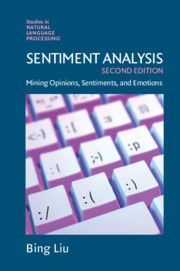Book contents
- Sentiment Analysis
- Studies in Natural Language Processing
- Sentiment Analysis
- Copyright page
- Contents
- Preface
- Acknowledgments
- 1 Introduction
- 2 The Problem of Sentiment Analysis
- 3 Document Sentiment Classification
- 4 Sentence Subjectivity and Sentiment Classification
- 5 Aspect Sentiment Classification
- 6 Aspect and Entity Extraction
- 7 Sentiment Lexicon Generation
- 8 Analysis of Comparative Opinions
- 9 Opinion Summarization and Search
- 10 Analysis of Debates and Comments
- 11 Mining Intent
- 12 Detecting Fake or Deceptive Opinions
- 13 Quality of Reviews
- 14 Conclusion
- Appendix
- Bibliography
- Index
4 - Sentence Subjectivity and Sentiment Classification
Published online by Cambridge University Press: 23 September 2020
- Sentiment Analysis
- Studies in Natural Language Processing
- Sentiment Analysis
- Copyright page
- Contents
- Preface
- Acknowledgments
- 1 Introduction
- 2 The Problem of Sentiment Analysis
- 3 Document Sentiment Classification
- 4 Sentence Subjectivity and Sentiment Classification
- 5 Aspect Sentiment Classification
- 6 Aspect and Entity Extraction
- 7 Sentiment Lexicon Generation
- 8 Analysis of Comparative Opinions
- 9 Opinion Summarization and Search
- 10 Analysis of Debates and Comments
- 11 Mining Intent
- 12 Detecting Fake or Deceptive Opinions
- 13 Quality of Reviews
- 14 Conclusion
- Appendix
- Bibliography
- Index
Summary
As discussed in Chapter 3, document-level sentiment classification is too coarse for practical applications. We now move to the sentence level and look at methods that classify sentiment expressed in each sentence. The goal is to classify each sentence in an opinion document (e.g., a product review) as expressing a positive, negative, or neutral opinion. This gets us closer to real-life sentiment analysis applications, which require opinions about sentiment targets. Sentence-level classification is about the same as document-level classification because sentences can be regarded as short documents. Sentence-level classification, however, is often harder because the information contained in a typical sentence is much less than that contained in a typical document owing to their length difference. Most document-level sentiment classification research papers ignore the neutral class mainly because it is more difficult to perform three-class classification (positive, neutral, and negative) accurately. However, for sentence-level classification, the neutral class cannot be ignored because an opinion document can contain many sentences that express no opinion or sentiment. Note that neutral opinion often means no opinion or sentiment expressed.
- Type
- Chapter
- Information
- Sentiment AnalysisMining Opinions, Sentiments, and Emotions, pp. 89 - 114Publisher: Cambridge University PressPrint publication year: 2020
- 2
- Cited by



